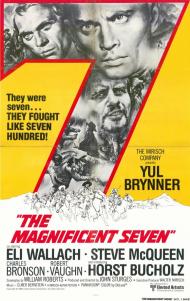Movie Review
A Fistful of Dollars
In his own way he is perhaps, the most dangerous man who ever lived!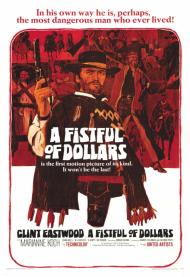
Italy Release Date: 09-12-1964
Directed by: Sergio Leone
Starring▸▾
- Clint Eastwood, as
- Joe
- Marianne Koch, as
- Marisol
- Gian Maria Volonte, as
- Ramon Rojo
- Wolfgang Lukschy, as
- John Baxter
- Sieghardt Rupp, as
- Esteban Rojo
- Joseph Egger, as
- Piripero
- Antonio Prieto, as
- Don Miguel Benito Rojo
- Jose Calvo, as
- Silvanito
- Margarita Lozano as
- Consuelo Baxter
![3.25 star[s] out of 4](http://www.threemoviebuffs.com/static/images/global/featured_gold_stars.png)
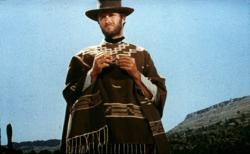
Clint Eastwood in A Fistful of Dollars
After playing Red Dead Redemption on the PS3 for the past few weeks, I decided to watch A Fistful of Dollars, the first of the Leone/Eastwood Westerns featuring The Man with No Name, which is clearly the inspiration for much of the look of the game. This is a darker and leaner Western than your brightly lit Technicolor epic Westerns of the 1950s. It's a short and violent movie that owes its success in equal parts to Clint Eastwood's squinty-eyed antihero, Morricone's brooding score and Leone's direction.
The story is a simple one. The Man with No Name (who's actually credited as Joe, although only referred to as such once in the movie), rides into a small Mexican town that is controlled by two powerful families. He sees an angle where he can pit the two of them against each other and earn some money for himself in the process. ("Baxter's over there, Rojo's there, me right smack in the middle. Crazy bell-ringer was right. There's money to be made in these parts.")
To prove himself, TMWNN has a gunfight with some of the Baxter men in the movie's most famous scene. Before the gunfight, TMWNN passes by the undertaker and tells him, "Get three coffins ready." He then approaches the group of men and tells them in that low, husky, Clint Eastwood voice that manages to be extremely threatening without ever yelling, "I don't think it's nice, you laughin'. You see, my mule don't like people laughing. He gets the crazy idea you're laughin' at him. Now if you apologize, like I know you're going to, I might convince him that you really didn't mean it." Following a very quick shoot out, TMWNN returns past the Undertaker and tells him, "My mistake. Four coffins...", having shot one more than he thought he would. It's an iconic moment and great cinema.
What Leone does with this movie is boil the Western down to its very essence, removing all the extraneous parts. You don't need exposition in a Western. You don't need a love story. You don't need a back story. You only need one man alone who is good with a gun and a horse who fights against the odds. Just throw in some gunfights and keep the running time under two hours and you've got a movie.
While he might be considered an antihero since his motives are so mercenary, TMWNN is still the good guy. His main goal is money, but at the same time he takes a chance and helps a damsel in distress, reuniting her with her husband. He's a stone cold killer, but he hints with just one line that maybe his heart still beats way down deep, or at least did once upon a time. When Marisol asks why he is helping them, he replies, "Why? I knew someone like you once. There was no one there to help. Now get moving."
Since the cast is made up of several different nationalities (it was filmed mainly in Spain) and all of them are speaking their native tongue, the film is dubbed. This makes the sound a bit odd and is perhaps the movie's only real weakness. It doesn't damage the enjoyment too much since thankfully Eastwood is doing his own voice. Other countries where his voice was dubbed by someone else are the real losers.
Although the look, feel, pacing and score are all part of the success of this movie, if it weren't for Eastwood, I doubt this movie would still be remembered. Charles Bronson, Steve Reeves, Richard Harrison and others were all offered the part before Eastwood. Fortunately for him and for us, they all turned it down.
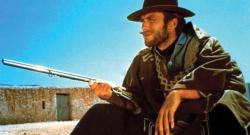
Clint Easwood in A Fistful of Dollars.
A Fistful of Dollars was a box office smash in 1964, becoming the highest grossing Italian movie up to that time. When it finally hit theaters in the United States in 1967 it grossed more than 14 million dollars in its initial run. Combining classic Western themes with a foreign film sensibility it became a sensation and turned Clint Eastwood into a superstar after years of struggling on the cusp of fame as an actor. For a Few Dollars More and The Good, the Bad and the Ugly would complete this classic trilogy of Spaghetti Westerns by Sergio Leone featuring Eastwood as the enigmatic Man With No Name.
It also resulted in a successful lawsuit from Japanese filmmaker Akira Kurosawa, who claimed it so closely copied his 1961 film Yojimbo that it infringed on his copyright and he therefore deserved financial remuneration. He eventually received 15% of the profits, and sole distribution rights in Japan, Taiwan and South Korea. In his defense Leone pointed out several other sources for his inspiration including an 18th Century play entitled Servant of Two Masters and a 1929 Dashiell Hammett novel called Red Harvest. Both of which may or may not have inspired Kurosawa as well.
Irregardless of where the idea for A Fistful of Dollars originated it stands as a wonderful movie.
The direction is particularly impressive. Leone uses dialogue sparingly. He also makes great use of extreme close-ups; framing and lingering on his character's faces like great oil paintings. He stages the action sequences with a sublime eye for the dramatic. Just check out the way he shoots TMWNN's climactic appearance through a wall of billowing smoke as it dissipates in the air.
Another innovation was how Leone filmed the shootouts. He put the camera behind the guy doing the shooting, thus giving the audience the point of view of looking over the character's shoulder and seeing the other guy getting shot in the same take. This stood in stark contrast to the standard Hollywood method of showing the shooter from the front and then cutting to the reaction shot of the victim.
As Scott wrote, Clint Eastwood certainly deserves credit for much of the movie's success. He gives a star making performance that succinctly solidified his standard character type. He helped create the iconic look of the character with his scruffy beard, poncho, black jeans and sawed-off black cigars, that most likely contributed to his trademark squint. Eastwood would play variations on TMWNM for the rest of his career. If you think about it Dirty Harry is really just an updated version of him.
As the movie goes along the violence grows in intensity right up to its ultra-violent crescendo. The body count is quite high and A Fistful of Dollars helped usher in the new era of revisionist Westerns. It served notice that the clear cut days of white hat vs. black hat were over. A Fistful of Dollars remains both a quintessential representative of its time and a timeless classic.
![3 star[s] out of 4](http://www.threemoviebuffs.com/static/images/global/featured_gold_stars.png)
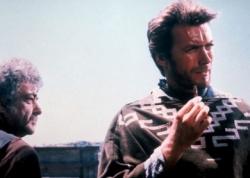
I heard you wanted to see me.
A Fistful of Dollars as well as The Magnificent Seven (1960) have both been credited for ushering in a new era of Westerns. Patrick wrote how Japanese filmmaker Akira Kurosawa claimed A Fistful of Dollars was based on a film of his, just as The Magnificent Seven was based on the Kurosawa film The Seven Samurai. Thus, the modern American western can be traced back to Japan, partially by way of Italy. Interesting to note is that The Magnificent Seven starred German born Horst Buchholz . So I guess we have, in part, the Axis powers of World War II to thank for how we see the modern western hero.
The iconic scene Scott mentioned with the coffins and the clever dialogue Eastwood speaks is the film's most famous scene but A Fistful of Dollars has many good moments. When Eastwood enters the tiny town, a yippy Chihuahua of a man barks at Eastwood several times, "You'll get rich here, or you'll be killed." Another line that always stays with me is when a man goes into his wife's bedroom and finds her in a partial state of undress. Eastwood is with her and she simply states to her husband, "Give him $500." What must be going through the husband's head at that second?
The Man With no Name is barely given any back story. Scott already noted the line that begins, "I knew someone like you once..." The only other one that refers to his history is when he is propping the corpses against the head stones and says, "The dead can be very useful sometimes...They've helped me out of tough spots more than once." It is not much to go on but certainly implies that he has had quite an eventful life and it adds to his mystique. This was also a key part of the seven gunfighters in The Magnificent Seven. All of their pasts are merely hinted at.
Where TMWNN separates himself from those seven guns for hire, is that he has balls of steel, or is far too smart for his own good. How you see him is based on how much you admire his actions. More than once he walks up to a group of armed men and kills all of them with only the slightest effort. He approaches gun fights with less apprehension than most of us do placing an order at McDonalds. He even takes a severe beating without ever yelling out.
The plot here is nothing great, leaving much of the film's success in the hands of the main character. I agree with both of my brothers that Eastwood makes this film what it is. With a squint and a stare that could frighten a nun, TMWNN is an iconic movie cowboy. He is a man of few words, and does not fear death. He thinks nothing of stirring up trouble to make a fistful of dollars but still recognizes right from wrong. If he has any weakness it is that he is a bit too sensitive about his mule. We may be able to trace much of the modern film cowboy movie to foreign sources but Clint Eastwood's performance is 100% American.
Photos © Copyright MGM/UA (1964)

